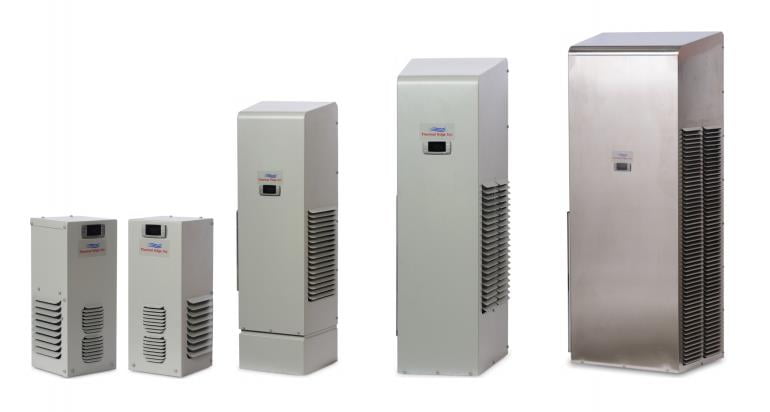Top 12 Maintenance Tips for an Enclosure Air Conditioner

Enclosure air conditioners are designed for long-term, trouble free operation. However, several items need regular attention to keep the unit running at its best. Here are eight regular maintenance tips that ensure reliable operation as well as four additional tips to help troubleshoot reasons for poor operation.
Regular maintenance
Choose suitable service intervals; these depend on the operating environment and how long it takes before the air filters become blocked. Refer to your air conditioner’s User and Technical Manual for guidance. Undertake the following tasks at each service to keep your air conditioner in tip-top condition:
- Check cabinet temperature: Verify the unit is running and check the enclosure temperature. If the temperature difference to the set point is more than 2 degrees, there may be a fault, and if so, consult the troubleshooting section below.
- Check alarms: A flashing snowflake indicator indicates an alarm condition. If P1 or P2 are showing, there is a fault with one of the temperature probes. CA indicates a low evaporator pressure and HA and LA indicate the enclosure temperature has exceeded the respective high or low temperature alarm settings. HA2 and LA2 indicate high and low condenser temperatures respectively.
- Check and clean air filters: Slide the filters out and inspect them. Discard damaged filters. If the filters are washable, clean them using a cleaning solution. If excessive filter fouling occurs, consider fitting a two-inch high capacity filter.
- Clean condensate evaporation system: Drain the pan and remove debris. Add a tablespoon of bleach to the upper pan to kill mold.
- Check enclosure door seals: Make sure the doors close properly and there are no air leaks.
- Check condenser: Clean the condenser coil if it’s dirty.
- Check fans: Verify the evaporator and condenser fans are running. Clean them if they are dirty. Replace them if they’re damaged or noisy.
- Check heater: If a heater is fitted, check that it operates at low ambient temperatures.
Air Conditioner Is Not Running
- If the unit is not running, check as follows:
- Power: Is the unit connected and is there power applied? Has the circuit breaker or fuse blown?
- Power switch: Is the switch on?
- Correct voltage: Is the supply voltage correct for the model; check the voltage on the nameplate.
Unit Overheating
- If there is a high temperature alarm or signs of the air conditioner overheating, check the following:
- Air inlet: Is it blocked?
- Fans: Are they running?
- Condenser coil: Is it dirty?
- Evaporator icing: This may indicate a faulty fan or refrigerant leak. Look for signs of an oily deposit on piping to confirm a leak.
Unit Has Power but Not Cooling
- If the air conditioner has power but is not cooling, check the following:
- Set Point: Make sure the set point is below ambient temperature.
- Compressor is running: Check that the evaporator and condenser fans are running. If the low condenser pressure alarm is energized, there may be a refrigerant leak. Alternatively, poor cooling may be due to an excessive heat load.
- Compressor not running: Check that the compressor contactor coil is energized and the contactor operates. Inspect the thermal overload on the compressor. A compressor with power that’s not running is usually faulty.
Intermittent Operation
- If the air conditioner is operating intermittently, check the following:
- Power supply: Make sure the fuse or circuit breaker is in good condition.
- Wiring: Look for a loose connection or short circuit.
- Compressor: A hot compressor may indicate a faulty unit that is running intermittently.
Request Service
Regular maintenance will keep your air enclosure air conditioner running efficiently. In the unlikely event of something going wrong and you cannot trace the fault, call the Thermal Edge Support Team.

